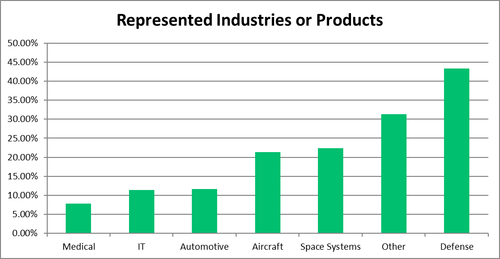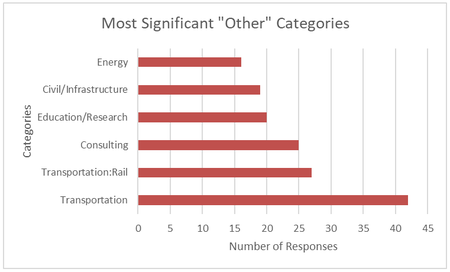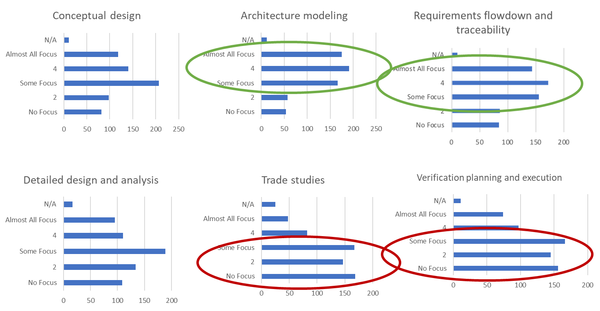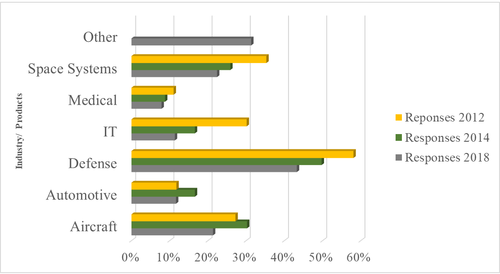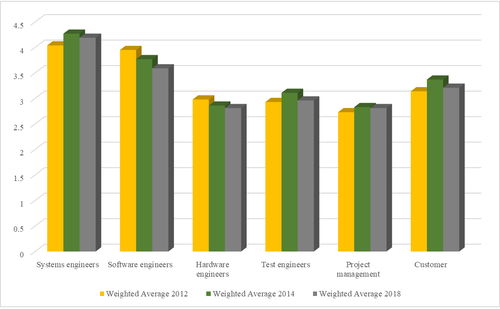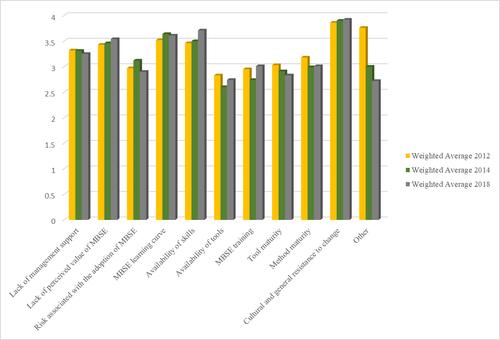Difference between revisions of "Model-Based Systems Engineering Adoption Trends 2009-2018"
| Line 149: | Line 149: | ||
The remainder of this article is going to look at some of the trends identified across the surveys, from 2009 to 2018. Figure 6 shows that MBSE is moving from a defense and space dominated practice into other industries as discussed in Figure 4. | The remainder of this article is going to look at some of the trends identified across the surveys, from 2009 to 2018. Figure 6 shows that MBSE is moving from a defense and space dominated practice into other industries as discussed in Figure 4. | ||
| − | [['''Figure 6.''' Shift of MBSE Adoption in New Industries (Cloutier 2019a, used with permission)]] | + | [[File:MBSE Trends Figure 6.png|thumb|center|500px|'''Figure 6.''' Shift of MBSE Adoption in New Industries (Cloutier 2019a, used with permission)]] |
Model-based systems engineering seems to be expanding in influence in that it is not just in the purview of the systems engineers. While systems and software engineers find value in MBSE practices, Figure 6 demonstrates that the customer is finding value in MBSE practices. It is also interesting that software engineers perceived value of MBSE is declining from survey to survey. | Model-based systems engineering seems to be expanding in influence in that it is not just in the purview of the systems engineers. While systems and software engineers find value in MBSE practices, Figure 6 demonstrates that the customer is finding value in MBSE practices. It is also interesting that software engineers perceived value of MBSE is declining from survey to survey. | ||
| − | [['''Figure 7.''' Perceived Value of MBSE Practices to Different Project Segments (Cloutier 2019a, used with permission)]] | + | [[File:MBSE Trends Figure 7.png|thumb|center|500px|'''Figure 7.''' Perceived Value of MBSE Practices to Different Project Segments (Cloutier 2019a, used with permission)]] |
| − | [['''Figure 8.''' Inhibitors to the Successful Adoption of MBSE within an Organization/Company (Cloutier 2019a, used with permission)]] | + | [[File:MBSE Trends Figure 8.png|thumb|center|500px|'''Figure 8.''' Inhibitors to the Successful Adoption of MBSE within an Organization/Company (Cloutier 2019a, used with permission)]] |
Figure 8 demonstrates that availability of MBSE skills, cultural and general resistance to change have continued to increase. Lack of perceived value reflects the findings in Figure 6 – software and hardware engineers are not seeing the value of MBSE. | Figure 8 demonstrates that availability of MBSE skills, cultural and general resistance to change have continued to increase. Lack of perceived value reflects the findings in Figure 6 – software and hardware engineers are not seeing the value of MBSE. | ||
Revision as of 18:33, 31 October 2019
Lead Author: Rob Cloutier
The MBSE Initiative was kicked off at the INCOSE International Workshop (IW) in 2007 at the Albuquerque, NM, USA Embassy Suites. There was approximately 45 INCOSE members for this first meeting, held the two days preceding IW.
Surveys were conducted in 2009, 2012, 2014, and 2018, and 2019 to better understand the adoption trends of model-based systems engineering.
Introduction
Model-based systems engineering (MBSE) is not a new concept. Wymore (1993) published the seminal work on the topic. This book presents the mathematical theory behind MBSE. Since that time, engineering has made significant movement from text-based approaches using office-based tools (e.g. Harvard Graphics, Microsoft PowerPoint, Microsoft Visio, etc.) to an interconnected set of graphical diagrams. These diagrams are generally created in a tool with a specialized graphical user interface.
Today aerospace engineers no longer use drafting boards to create their drawings – they use computer aided design (CAD) tools. Likewise, software engineers seldom use EMACS or Vi (text editors), instead, they use software GUIs that allow them to code, check syntax, compile, link, and run their software all in a single environment.
Broadly speaking, a {{Term|Model_(glossary)]] can be thought of as a facsimile or abstraction of reality. To this end, even a requirements document can be considered a model – it represents what a real system should do in performing its mission or role. While systems engineering has used models for a very long time, MBSE is the systems engineering migration to computer-based graphical user interfaces to perform our analysis and design tasks just as our other engineering brethren have moved to computer-based graphical user interfaces.
A discussion of available tools is beyond the scope of this article, and not the practice of the SEBoK to review or promote specific tool offerings. However, it is fair to state that current MBSE tools fall into three broad categories: 1) Functional decomposition tools that use IDEF0 (also called IPO) diagrams, N2 diagrams, functional flow block diagrams, etc., 2) Object-oriented tools that implement the Object Management Group’s Systems Modeling Language (SysML), and 3) Mathematical modeling tools.
This migration for systems engineering might have begun in the late 90’s. The INCOSE INSIGHT publication proclaimed that MBSE was a new paradigm (INSIGHT 1998). Cloutier (2004) addressed the migration from a waterfall systems engineering approach to an object-oriented approach on the Navy Open Architecture project. At that time, SysML did not exist, and the teams were using the Unified Modeling Language (UML) that was predominately a software modeling tool. Zdanis & Cloutier (2007a, 2007b) addressed the use of activity diagrams instead of sequence diagrams for systems engineering based on the newly released SysML. In 2009, the INCOSE INSIGHT publication proclaimed MBSE was THE new paradigm (INSIGHT 2009).
Approach
In 2009 a survey was commissioned by the Object Management Group (OMG) with the intent of informing the SysML Working Group on necessary changes to SysML since its first release [Cloutier & Bone 2010). That survey focused on process more than adoption. Beginning in 2012, INCOSE has commissioned three more surveys to understand adoption trends and obstacles. The survey instrument remained relatively unchanged for 2012, 2014, and 2018 (Cloutier 2015, Cloutier 2019a). In January of 2019, the Jet Propulsion Lab (JPL) conducted an MBSE Workshop (Cloutier 2019b). A survey of those participants was conducted, and the intent of the questions was to augment knowledge gained from the 2018 survey. The table below shows the number of respondents in each of the surveys.
| Year | Survey Purpose | Responses |
|---|---|---|
| 2012 | INCOSE MBSE Initiative | 134 |
| 2014 | INCOSE MBSE Initiative | 205 |
| 2018 | INCOSE MBSE Initiative | 661 |
| 2019 | JPL MBSE Workshop | 98 |
Responses and Response Demographics
Each survey was sent to a diverse group of MBSE practitioners. Table 2 shows that of the 661 responses for the 2018 survey, 410 indicated their country of origin. This international representation is similar to all surveys conducted.
| Country | Responses | Country | Responses |
|---|---|---|---|
| USA | 197 | Israel | 4 |
| United Kingdom | 52 | Singapore | 3 |
| France | 30 | China | 2 |
| Germany | 28 | New Zealand | 2 |
| Australia | 20 | Poland | 2 |
| Netherlands | 19 | Russia | 1 |
| Japan | 8 | Romania | 1 |
| Canada | 6 | Turkey | 1 |
| Italy | 6 | Columbia | 1 |
| Sweden | 6 | Norway | 1 |
| South Africa | 5 | South Korea | 1 |
| Switzerland | 4 | UAE | 1 |
| Brazil | 4 | Belarus | 1 |
| India | 4 |
As part of the demographics, Figure 1 shows the represented industries. Because the “Other” category was so large, the data was analyzed to better understand Figure 2.
The 2018 survey indicated that there seems to be an increased application of MBSE in traditionally civil engineering industries – specifically energy, infrastructure, and transportation (Figure 2) One of the most interesting aspects of the 2018 survey is the finding that MBSE is being applied in the early phases of systems engineering, and less so in the later phases as shown in Figure 3.
This was confirmed by the JPL question “Where do we believe MBSE holds the most promise?” Figure 4 shows that 76% of the responses indicated System/subsystem architecting, 42% thought requirements analysis, and 39% believed early conceptualization (note: the question allowed for multiple answers).
When asked whether the JPL survey respondents believed that their systems modeling experience is recognized as a valued skill supporting career growth of systems engineers in my organization, just over 50% believed management valued their experience. A smaller number, 21%, believed their modeling experience was not valued (Figure 5).
Key Adoption Trends
The remainder of this article is going to look at some of the trends identified across the surveys, from 2009 to 2018. Figure 6 shows that MBSE is moving from a defense and space dominated practice into other industries as discussed in Figure 4.
Model-based systems engineering seems to be expanding in influence in that it is not just in the purview of the systems engineers. While systems and software engineers find value in MBSE practices, Figure 6 demonstrates that the customer is finding value in MBSE practices. It is also interesting that software engineers perceived value of MBSE is declining from survey to survey.
Figure 8 demonstrates that availability of MBSE skills, cultural and general resistance to change have continued to increase. Lack of perceived value reflects the findings in Figure 6 – software and hardware engineers are not seeing the value of MBSE.
Conclusions
Surveys conducted between 2012 and 2018 demonstrate that MBSE practices are spreading beyond traditional Defense and Space domains. Most MBSE practitioners are finding MBSE is most useful in the early project phases of conceptualization, requirements analysis, and systems architecting. There continues to be a skills shortage, yet companies/organizations are providing less training to improve MBSE skills. Both systems engineers, systems engineering management, and the systems engineering customer are finding value to using models to perform systems engineering.
References
Works Cited
Cloutier, R. 2004. "Migrating from a Waterfall Systems Engineering Approach to an Object Oriented Approach – Lessons Learned." ICSE and INCOSE Region II Conference, 15 September 2004, Las Vegas, NV.
Cloutier, R. and M. Bone. 2010. "Compilation of SysML RFI- Final Report: Systems Modeling Language (SysML) Request For Information." OMG Document: syseng/2009-06-01. Report date: 02/20/2010. Retrieved from http://www.omgwiki.org/OMGSysML/lib/exe/fetch.php?media=sysml-roadmap:omg_rfi_final_report_02_20_2010-1.pdf on 10/24/2019
Cloutier, R. 2015. "Current Modeling Trends in Systems Engineering." INSIGHT, A Publication of the International Council on Systems Engineering (INCOSE). Volume 18, Issue 2.
Cloutier, R. 2019a. "2018 MBSE Survey Results." Proceedings of the 2019 INCOSE MBSE Workshop, presented at the INCOSE 2019 International Workshop, 26-29 January 2019, Torrance, CA.
Cloutier, R. 2019b. "2019 JPL MBSE Survey Results." Presented at the 2019 Jet Propulsion Lab (JPL) MBSE Workshop, January 2019, Pasadena, CA.
INSIGHT. 1998. Model-Based Systems Engineering: A New Paradigm. A Publication of the International Council on Systems Engineering (INCOSE). Volume 1, Issue 3.
INSIGHT. 2009. Special Edition on Model-based Systems Engineering: The New Paradigm. A Publication of the International Council on Systems Engineering (INCOSE). Volume 12, Issue 4.
Wymore, W. 1993. Model-Based Systems Engineering. Boca Raton, FL: CRC Press.
Zdanis, L. and R. Cloutier. 2007. "The Use of Behavioral Diagrams in SysML." Hoboken, NJ: Stevens Institute of Technology. Proceedings of the Conference on Systems Engineering Research (CSER) 2007, 14-16 March 2007, Hoboken, NJ, USA. ISBN 0-9787122-1-8.
Zdanis, L. and R. Cloutier. 2007. "The Use of Behavioral Diagrams in SysML." IEEE Long Island Systems, Applications and Technology Conference, Farmingdale, NY, 2007, pp. 1-1. doi: 10.1109/LISAT.2007.4312634
Primary References
Bone, M. and R. Cloutier. 2010. "The Current State of Model Based Systems Engineering: Results from the OMG™ SysML Request for Information 2009." Proceedings of the 8th Conference on Systems Engineering Research (CSER), 17-19 March 2010, Hoboken, NJ. http://www.omgsysml.org/news-articles.htm
Cloutier, R. and M. Bone. 2012. "MBSE Survey 2." Presented at the International Council on Systems Engineering (INCOSE) International Workshop, 21-24 January 2012, Jacksonville, FL.
Cloutier, R. 2019a. "2018 MBSE Survey Results." Proceedings of the 2019 INCOSE MBSE Workshop, presented at the INCOSE 2019 International Workshop, 26-29 January 2019, Torrance, CA.
Cloutier, R. 2019b. "2019 JPL MBSE Survey Results." Presented at the 2019 Jet Propulsion Lab (JPL) MBSE Workshop, January 2019, Pasadena, CA.
Additional References
Batarseh, O., L. McGinnis, J. Lorenz. 2012. “MBSE Supports Manufacturing System Design.” Proceedings of the 22nd Annual International Council of Systems Engineering (INCOSE) International Symposium, 9-12 July 2012, Rome Italy. Paper ID: 2950
Kernschmidt, K., B. Vogel-Heuser. 2013. "An interdisciplinary SysML based modeling approach for analyzing change influences in production plants to support the engineering." Proceedings of the 2013 IEEE International Conference on Automation Science and Engineering (CASE), 17-20 Aug. 2013. pp.1113-1118. doi: 10.1109/CoASE.2013.6654030
Gulan, S., S. Johr, R. Kretschmer, S. Rieger, M. Ditze. 2013. “Graphical Modelling meets formal methods." Proceedings of the 11th IEEE International Conference on Industrial Informatics (INDIN), 29-31 July 2013. pp.716-721. doi: 10.1109/INDIN.2013.6622972
Hoffmann, H. 2012. "Streamlining the development of complex systems through model-based systems engineering," Proceedings of the 2012 IEEE/AIAA 31st Digital Avionics Systems Conference (DASC), 14-18 Oct. 2012. pp.6E6-1,6E6-8. doi: 10.1109/DASC.2012.6382404
Paredis, C.J.J., Y. Bernard, R.M. Burkhart, H.P. de Koning, S. Friedenthal, P. Fritzson, N.F. Rouquette, W. Schamai. 2010. "An overview of the SysML-Modelica transformation specification." Proceedings of the 2010 International Council on Systems Engineering (INCOSE) International Symposium, 11-15 July 2010, Chicago, IL.
Pihlanko, P., S. Sierla, K. Thramboulidis, M. Viitasalo. "An industrial evaluation of SysML: The case of a nuclear automation modernization project." Proceedings of the 18th IEEE Conference on Emerging Technologies & Factory Automation (ETFA), 10-13 September 2013. pp.1-8. doi: 10.1109/ETFA.2013.6647945
Ramos, A.L., J.V. Ferreira, J. Barcelo. "Model-Based Systems Engineering: An Emerging Approach for Modern Systems." IEEE Transactions on Systems, Man, and Cybernetics, Part C: Applications and Reviews. 42(1):101-111, Jan. 2012. doi: 10.1109/TSMCC.2011.2106495
< Previous Article | Parent Article | Next Article >
